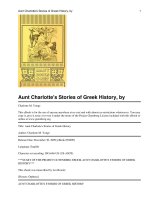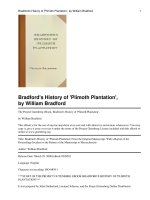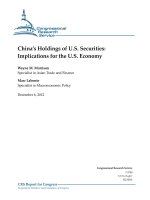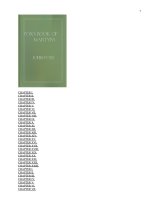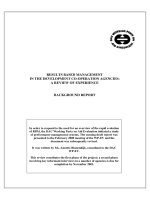the gospel hoax morton smith's invention of secret mark
Bạn đang xem bản rút gọn của tài liệu. Xem và tải ngay bản đầy đủ của tài liệu tại đây (1.63 MB, 174 trang )
The Gospel Hoax
ou0 ga_re0stin krupto_ne0a_nmh_ i3na
fanerwqh|~,ou0de_ e0ge/net a)po&krufon
a)ll ) i3na e1lqh| ei0j fanero/n.
For nothing has been hidden except to be
uncovered, nor anything made secret but
to come into the open.
Mark 4:22
Morton Smith’s Invention of Secret Mark
Stephen C. Carlson
Baylor University Press
Waco, Texas
The Gospel Hoax
© 2005 by Stephen C. Carlson
Waco, Texas 76798
All Rights Reserved. No part of this publication may be reproduced, stored in
a retrieval system, or transmitted, in any form or by any means, electronic,
mechanical, photocopying, recording or otherwise, without the prior per-
mission in writing of Baylor University Press.
Book Design by Diane Smith
Cover Design by Pam Poll
The images that appear in this book are in the public domain or are
otherwise permitted by law. Figures 6 and 7 can only be used as they
appear in this book by permission of Baylor University Press.
The Figures are credited as follows:
Figure 1: Albert S. Osborn
Figure 2: Kenneth W. Clark
Figure 3: Morton Smith
Figure 4: Morton Smith
Figure 5: Morton Smith
Figure 6: Stephen C. Carlson
Figure 7: Stephen C. Carlson, Kenneth W. Clark, and Morton Smith
Library of Congress Cataloging-in-Publication Data
Carlson, Stephen C.
The Gospel hoax : Morton Smith's invention of Secret Mark / Stephen
C. Carlson.
p. cm.
Includes bibliographical references (p. ).
ISBN 1-932792-48-1 (pbk. : alk. paper)
1. Smith, Morton, 1915- . 2. Secret Gospel according to Mark.
I. Title.
BS2860.S42C37 2005
229'.8 dc22
2005026081
Printed in the United States of America on acid-free paper
Dedication
To Aili, my wife and my love
vii
Contents
Foreword by Larry W. Hurtado ix
Preface xv
Introduction 1
1 The Revelation of Secret Mark 5
2 Uncovering Literary Fakes 13
3 The Modernity of the Mar Saba Manuscript 23
4 The Modernity of Theodore 49
5 The Modernity of Secret Mark 65
6 Morton Smith’s Secret Uncovered 73
7 The Anatomy of an Academic Hoax 87
Appendix: Extracts from Smith’s 1960 Catalog 99
Notes 103
Works Cited 131
Index 143
ix
Foreword
During his visit to the library of the Mar Saba monastery in
1958, did Morton Smith happen upon a reference to a previ-
ously unknown version of the Gospel of Mark in a previously
unknown letter of the important early church figure, Clement
of Alexandria, or did Smith himself create this text, thereby
producing one of the most sensational scholarly hoaxes of
modern times? In the decades since Smith first made the pur-
ported letter of Clement public, with its tantalizing and
provocative excerpts of a putative secret version of the Gospel
of Mark, there have been occasional and unresolved contro-
versies about its genuineness, and, consequently, in scholarly
circles there has been a widespread uncertainty about what to
make of the text. On the other hand, understandably reluctant
to think that a scholar of Smith’s standing would have stooped
to such a hoax, and irresistibly drawn by the whiff of esoteric
Christian practices and suppressed versions of the Gospel of
Mark, some scholars have adopted the text as a trustworthy
source to use in historical reconstructions of early Christianity.
For these scholars especially, the stakes involved in questions
about the alleged letter of Clement and “secret Mark” are high.
But for everyone concerned about making use of any bona fide
source for the study of Christian origins, the questions about
secret Mark have large consequences, and elicit eager interest.
Moreover, beyond scholarly circles secret Mark has found a
strong popular interest as well. This is perhaps partly because
ours is a time of enormous popular curiosity about early
Christian diversity, great sympathy for allegedly suppressed ver-
sions of ancient Christianity, and a touching readiness among
the general public to accept various claims that scholarly and
ecclesiastical intrigues have combined to cover up some early
Christian teachings, texts and practices. In this atmosphere, it
seems to require surprisingly little to generate a very receptive
popular attitude toward a text like secret Mark. But is secret
Mark a suppressed and long-forgotten gospel text, or is it a
phantom-text, conjured by a particularly clever hoaxer to play
to certain types of wishful thinking?
Stephen Carlson’s study of the purported letter of Clement is
small in size but packs a powerful punch. Others have raised
questions about the text, and several scholars have lodged
astute observations that suggest that it is a fake. But Carlson
presents by far the most thorough investigation to date.
Indeed, it is difficult to think of anything that he has left unex-
amined. He judiciously weighs all the observations and argu-
ments of previous scholars for and against the authenticity of
the text, and this in itself would make his discussion a valuable
contribution. But, in addition, Carlson deploys a further bat-
tery of original observations, among which his analysis of the
properties of the handwriting of the text opens up a whole new
line of discussion. Drawing upon the forensic science involved
in forgery-detection, Carlson gives what seems to me convinc-
ing evidence that this purported letter of Clement was penned
by someone trying to pass it off as an eighteenth-century
manuscript.
Furthermore, combining impressively thorough investigation
of all the relevant historical issues with his training as a lawyer,
Carlson marshals a powerful case that the most likely person
who perpetrated the hoax is the internationally celebrated
scholar of ancient Judaism and Christianity, Morton Smith,
xTHE GOSPEL HOAX
who presented this letter of Clement as a discovery made while
cataloguing books in the Mar Saba library. Carlson argues that
Smith uniquely had the abilities, the opportunity, and the
motives.
I suspect that for most scholars, Carlson’s rather well-
researched and powerful case that Smith created this letter of
Clement will comprise the really worrying matter. The charge
that Smith fabricated the letter of Clement and that the puta-
tive excerpts from a secret Mark are phoney is not just aca-
demic tittle-tattle; it is genuinely disturbing. Some scholars
(myself included) have suspected that the letter may be a fake,
or have allowed for this possibility, but have been very reluc-
tant to think that a respected member of the scholarly guild
(even such a colorful character as Smith was) would bend his
considerable abilities to fabricating a text and put it forth as
genuine. Scholarship depends, to a greater degree than we
sometimes realize, on trust, scholars abiding by self-imposed
rules of the game. And the game is not supposed to involve
such trickery. Indeed, for some scholars, this reluctance to
think that Smith would do such a thing appears to be the
major reason for treating the Clementine letter as genuine. So,
if Carlson is right (and, so far as I can tell, he has presented a
rather compelling phalanx of argumentation), then the case of
secret Mark raises uncomfortable questions about the integrity
of our scholarly culture. On the other hand, Smith was an
unusually clever and impressively well-prepared scholar, so
maybe we need not fear many other hoaxes so well crafted!
However, for scholars particularly, the more substantial ques-
tion by far is whether the Clementine letter is genuine or a
fake. Can this text be used as a valuable second-century pri-
mary source for historical investigation of early Christianity
and the transmission-history of the Gospel of Mark, or is the
letter really only a modern curiosity, an artefact of learned
sleight-of-hand, an especially clever practical joke played upon
scholars in the field, and therefore worthless for the study of
FOREWORD xi
Christian origins? Of course, any suggestion of fakery justifiably
raises the question about who might have prepared such an
impressively deceptive text, and Carlson rises to this demand.
But I want to emphasize that for the study of early Christianity
the key matter is whether the Clementine letter is genuine. My
judgment is that Carlson’s case against the authenticity of the
text is persuasive, decisive, practically unanswerable. Certainly,
anyone who now wishes to treat the Clementine letter as a
valid second-century text will first have to try to refute
Carlson’s case in at least an equally detailed and thorough man-
ner. Carlson has now made it impossible to give secret Mark the
benefit of doubt, or to sit on the fence and avoid the issue.
Carlson offers the results of a meticulous and amazingly
wide-ranging investigation of sources, a detailed and creative
analysis involving wholly new matters not previously addressed
(such as study of the handwriting of the Clementine letter),
and fascinating proposals that Smith himself embedded the
text and his references to it with clever clues that it is a hoax.
Also, helpfully pointing out the distinctions between a forgery
(usually done for financial gain) and a hoax (usually intended
more to demonstrate the cleverness of the hoaxer), Carlson
emphasizes that the purported letter of Clement should be
judged a particularly clever and spectacularly successful instance
of a scholarly hoax.
As the case for any scholarly claim, Carlson’s study will now
be subjected to the judgment of other scholars concerned with
historical investigation of early Christianity. But to give his
case an adequate assessment will require a commitment to
thoroughness and clear thinking equivalent to what Carlson
demonstrates. I think I can safely estimate where fair-minded
scholarship will come down in the end, recognizing Carlson’s
diligent and cogent exposure of Smith’s letter of Clement and
its references to a secret Mark as an impressive fake. But if the
text is more appropriately placed in the curio cabinet than on
the shelf of primary texts of early Christianity, we can at least
xii THE GOSPEL HOAX
be grateful that the matter appears now rather clearly settled. It
will be disappointing to some, and others will say “I told you
so.” But the more important matter is that we can now get on
with the very real demands of engaging the remaining genuine
early Christian sources. And, I suggest, we should also probably
allow ourselves a belated congratulatory laugh, with Morton
Smith, over this ingenious fabrication that drew so much inter-
est and for so long defied our best efforts to satisfy ourselves
whether it was real or a hoax.
Larry W. Hurtado
FOREWORD xiii
xv
I first heard of the Secret Gospel of Mark as a teenager in the
mid 1980s when I read an extract of it quoted in the Holy
Blood, Holy Grail series—a sensationalistic exposition of the
supposed bloodline of Jesus Christ and Mary Magdalene, which
has just resurfaced in the public’s imagination as the back-
ground for the fictional thriller, The Da Vinci Code. Even
though I was not very familiar with the New Testament back
then, the extract from Secret Mark, with its sentences begin-
ning with “and straightaway,” appeared to me exactly like I
expected the author of the Gospel of Mark to have written.
Secret Mark did not make much of an impression on me, how-
ever, and I missed the homoerotic intimation at the end of the
passage. Perhaps I was a bit too young to notice it, but the
authors of the Holy Blood, Holy Grail series did not call atten-
tion to it presumably because it would have contradicted their
central premise. Rather, they focused on what Clement of
Alexandria, the person who supposedly quoted Secret Mark,
had to say about suppressing heretical gospels.
The first time I realized that Secret Mark could well be a
modern fake was in 1995 when a very spirited discussion sprang
up on a couple of academic mailing lists around the time
Andrew H. Criddle’s article in the Journal of Early Christian
Preface
Studies (JECS) was published. Several scholars I had already
respected even expressed their suspicions that it was forged by
its discoverer, the late Morton Smith, a professor of ancient
history at Columbia. Then I read Criddle’s article, and I con-
cluded that he presented a compelling statistical analysis that
whoever wrote the letter attributed to Clement of Alexandria
had tried too hard to make it look like Clement. It was
overkill. Thus, I began wondering: if Secret Mark was a fake
of some sort, what kind of a fake would it be? Was it the
eighteenth-century idle musings of a bored Greek Orthodox
monk or a Dutch humanist? More sinister possibilities also
occured to me: Was Morton Smith a victim of a malicious for-
gery, or did he himself have something to do with it? And, if so,
why? These questions did not have easy answers, and I recall
thinking that it would be a great puzzle for someone else to
solve one day because I was about to finish law school and
begin a career as a patent attorney. I had no real inkling, how-
ever, that eight years later I would make my own attempt to
solve the puzzle. This book is the result.
Three very different things in 2003 impelled me to try solv-
ing the mysteries of Secret Mark: a forgery controversy over an
artifact, a Supreme Court opinion, and a special issue in an
academic journal. The controversial artifact was the James
ossuary, a limestone bone-box bearing the inscription: “James
son of Joseph, brother of Jesus.” In the spring of 2003, the
Israeli Antiquities Authority announced that it was a forgery,
and, with my trust in technology, I wanted to know what went
wrong with the initial geophysical examination. I reread the
report, this time critically, and I was shocked to discover how
incompetent it was. Michael Turton made a comment about it
on the Crosstalk mailing list. Turton observed that obtaining
control over the process of authentication is an important
component of what he called a “forgery arc.” That comment
stuck with me and led me to revisit how the document con-
taining Secret Mark was authenticated.
xvi THE GOSPEL HOAX
As part of my vocation, I follow the written opinions and
decisions of the U.S. Supreme Court. One case was Lawrence v.
Texas, which struck down as unconstitutional state laws crimi-
nalizing consensual, same-sex sodomy. In the opinion, Justice
Anthony Kennedy presented an insightful, historical overview
explaining how societal and legal attitudes toward homosexual
activity have greatly changed over the years. This became
important later.
The third trigger was a set of three articles devoted to Secret
Mark in the Summer 2003 issue of the Journal of Early Christian
Studies. These let me know that the controversy over Secret
Mark was still just as heated as it was back in 1995 and no more
settled. In fact, I was getting frustrated that, except for the pub-
lication of some new color photographs of it in 2000, there had
been little movement on the question—a “stalemate in the
academy,” as Charles Hedrick titled the lead article.
I wondered if a fresh look from a different approach might be
more successful in ending the stalemate, and I decided to apply
my legal training to see if I could get anywhere. To do so, I had
to research the law to recognize relevant facts to the Secret Mark
case, sift through the facts to identify the evidence I could use,
and organize the evidence into a coherent story. In this case, the
“law” constitutes the methods used by literary critics in evaluat-
ing forgeries, and I found that Anthony Grafton’s book, Forgers
and Critics, was immensely helpful. Grafton explains that literary
forgeries become easier to detect with the passage of time
because assumptions about the past, which the forger took for
granted, become obsolete and then obvious. Thinking back to
Lawrence v. Texas, I considered whether Grafton’s criterion
could be evident in Secret Mark’s treatment of homosexuality. I
looked into how homosexuality was viewed or “socially con-
structed” in antiquity and realized that whoever wrote Secret
Mark misunderstood it. Masquerading as an ancient text, Secret
Mark exuded the sexual mores of the 1950s. No wonder it caught
so much more attention than any other new gospel discovery!
PREFACE xvii
After reading Author Unknown, Don Foster’s experience of
unveiling the anonymous author of Primary Colors, I also
learned that purely literary arguments are not as persuasive to
the general public as material evidence such as handwriting
samples and confessions. Even though the literary analysis con-
vinced me that I was on the right track, I knew I needed
stronger evidence. My inspiration for finding the stronger evi-
dence came from two places. First, my friend Jack Poirier told
me that he possessed samples of Smith’s handwriting and knew
where to find more. Second, in his discussion on Secret Mark,
Bart Ehrman mentioned the story of Dionysius the Renegade,
who forged a play to fool his rival and was clever enough to
encode the work’s real nature within the play itself. By this
time I had read enough of Smith’s writings to suspect that, if he
did have something to do with it, his sense of humor was such
that he could have salted Secret Mark with clues, revealing its
true nature. Now that I knew what to look for and where to
look for it, all I had to do was to find it.
Because this is my first book, there are many people I would
like to thank. First, I would like to thank my parents, who sac-
rificed to make sure that I had a well-rounded liberal arts edu-
cation that included the classics, even though my focus was on
computers. I would also like to thank James A. Bigger for
teaching me Latin and giving me a taste for Greek, and Dr.
Helen Pope at St. Stephen’s School in Rome for agreeing to
teach me Greek even though I was the only student who
signed up for the class. Mark Goodacre, my fellow soldier in
the synoptic problem, whom I have come to regard as a close
friend, also deserves my gratitude for always challenging me to
publish my ideas (the good ones, that is) even though my doc-
torate is in a different field. My 2001 article on Clement of
Alexandria would not have been written, much less submitted
to New Testament Studies for publication, without his encour-
agement. Little did I realize my involvement with Clement
would not be over.
xviii THE GOSPEL HOAX
As for the book itself, I owe my appreciation to many people
who listened to my ideas or read my drafts and shared their
assessments with me. These include Mark Goodacre, of course,
Andrew Criddle, Jeffrey Gibson, Jack Poirier, Jeffrey Peterson,
Mark Matson, Edward Hobbs, Carl Conrad, Ken Olson,
Michael Turton, Shawn Kelley, David Landry, Gail Dawson,
and Ulrich Schmid. Julie C. Edison, a professional forensic
document examiner, gave me very helpful advice. Jeffrey
Gibson, in particular, deserves to be singled out for overcoming
my reticence and insisting that I talk with Larry Hurtado and
Bart Ehrman about this. Both Larry and Bart were very sup-
portive and gave me much useful feedback. Larry also intro-
duced me to my editor, Carey Newman of Baylor University
Press, who continues to amaze me with his passion for my
book, his knowledge of the publishing business and the bibli-
cal studies field, his challenging me on the “framing meta-
narrative,” and his lining up the kind of peer review this book
required. All the anonymous reviewers made very helpful com-
ments and the book is much stronger as a result. All remaining
errors, of course, are solely mine.
I would also like to express my appreciation to my friends,
coworkers, and family for their encouragement and their
patience in letting me express what I am doing, even if it must
have seemed a little obscure. These include Scott, Jackie,
Mike, and April in our small group; my law partner, Keth
Ditthavong, along with Linda, Margo, Sera, Ti, and Stephen at
the office; and my parents, my brother Chris, and my in-laws,
especially Heli and Sven. In particular, Heli helped a lot with
the index.
Most of all, I would like to thank and dedicate this book to
Aili, my wife, my love, and mother of my children. Without
her support, encouragement, prayers, and faith, this book
would never have been completed.
PREFACE xix
1
Introduction
Secret Mark first became known to modern scholarship in 1958
when a newly hired assistant professor at Columbia University
by the name of Morton Smith visited the monastery of Mar
Saba near Jerusalem and photographed its fragments.
1
Announced on the heels of many spectacular discoveries of
ancient manuscripts in the Near East, such as the Dead Sea
Scrolls and the Nag Hammadi gnostic corpus, Secret Mark
promised to be just as sensational, featuring a passage from a
previously unknown, secret edition of the Gospel of Mark.
If its disclosure was sensational, its contents were stunning.
The secret passage, written in Mark’s characteristic style, told
the story of a youth who had been buried in a tomb. His sister
came to Jesus and begged him to resurrect her brother. Yet,
unlike—or even contradicting—the Lazarus account in John,
the youth was still alive when Jesus reached him. Stun turned
to scandal as the secret gospel went on to narrate that “the
youth comes to him, wearing a linen cloth over his naked body.
And he remained with him that night, for Jesus taught him the
mystery of the kingdom of God” (Clement 447). But this was
not the end of the mysteries surrounding Secret Mark.
Compounding the mystery were the peculiarities of its
preservation. Unlike the finds at Qumran and Nag Hammadi,
Secret Mark was not preserved in any ancient document. It was
found as a quotation in a letter, also previously unknown,
ascribed to Clement of Alexandria that was copied into the
end papers of an early modern book. The book was an edition
of the genuine letters of Ignatius printed in 1646,
2
but the
handwritten copy of Clement’s supposed letter was written at
least a hundred years later than that because its Greek hand-
writing resembles that of the eighteenth century (Clement 1).
Physical tests of the Dead Sea Scrolls can confirm their antiq-
uity, for example, but no physical test of Secret Mark’s manu-
script can confirm that its text is older than the 1700s.
In fact, no physical test had ever been performed on the
manuscript because it had not been secured for laboratory
study before it was lost. After Smith photographed the text in
1958, he left the manuscript in the tower library of the isolated
monastery and did not return. The next time it was seen by
western scholars was eighteen years later, when it was trans-
ferred to the Greek Orthodox Patriarchate library in Jerusalem
for further study.
3
While there, the manuscript was removed
from the book, photographed in color, and then misplaced.
4
Its
current whereabouts are unknown, but, if it still exists, it is pre-
sumably somewhere in the Patriarchate library. Thus, the only
surviving physical traces of this momentous text are the two
sets of photographs taken first in 1958 and then in 1976. There
is only a slender hope that the manuscript might reappear.
If Secret Mark was controversial because of its mix of sex and
religion, it did not take long to add politics to the fray. When
Smith published his findings in 1973, some of the reviews of
his work were unusually strident and personal.
5
Shawn Eyer has
conveniently surveyed these reviews and discussed one of the
reactions as follows:
Only one reviewer, Fitzmeyer [sic], saw it worthwhile to
point out that Morton Smith was bald. Whatever impor-
tance we may attach to the thickness of a scholar’s hair, it
seems that detached scholarly criticism fails when certain
tenets of faith—even “enlightened” liberal faith—are called
into question.
6
2THE GOSPEL HOAX
The personalization of the debate soon went beyond observa-
tions of Smith’s follicles and led to insinuations of his forgery.
Delicately but unmistakably, Quentin Quesnell broached the
issue of forgery in 1975, generating a heated exchange the fol-
lowing year.
7
Neither Quesnell nor Smith gave ground and the
controversy continued. Some took Smith’s side on the antiquity
of Secret Mark and explored how the canonical Mark could
have been a censored version of Secret Mark.
8
Others occasion-
ally questioned the authenticity of Secret Mark only to have
Smith tenaciously counterattack the weaknesses of their argu-
ments.
9
Little was settled by Smith’s death in 1991. If anyone was
waiting for a deathbed confession, it did not come.
10
Perhaps
exhausted over the unproductive battle, biblical critics began
coalescing into the position that Secret Mark postdates the
canonical Mark and was written sometime after the first cen-
tury, perhaps during second-century Alexandria.
11
Larry W.
Hurtado epitomizes the academy’s attitude over the text as
follows:
Furthermore, as a good many other scholars have concluded,
it is inadvisable to rest too much on Secret Mark. The
alleged letter of Clement that quotes it might be a forgery
from more recent centuries. If the letter is genuine, the
Secret Mark to which it refers may be at most an ancient but
secondary edition of Mark produced in the second century
by some group seeking to promote its own esoteric inter-
ests.
12
But this settlement has less to do with where Secret Mark
belongs and more to do with where Secret Mark does not
belong: biblical critics are assigning Secret Mark to a time just
late enough to be ignored.
13
Because of the uncertainty over
its authenticity, some scholars out of prudence, refuse to make
use of Secret Mark, even when it supports their results.
14
Not
only that, an increasing number of scholars are putting them-
selves on the record as questioning not only Secret Mark’s
INTRODUCTION 3
authenticity but also Smith’s role in it.
15
In what has been
aptly dubbed a “stalemate in the academy,” the lingering con-
troversy continues to overshadow any serious investigation
into the contents of Secret Mark.
16
Just because Secret Mark is being largely ignored does not
mean that it is going away. It is still being invoked, though
with some hedging, as a convenient illustration for early gospel
traditions found outside the New Testament. For example, one
scholar recently wrote: “Revisions of Mark seem to have gone
on well into the second century since Clement of Alexandria
knows of three versions of the Gospel of Mark: the novice,
spiritual, and Carpocratian versions.”
17
In 1999 the first doc-
toral dissertation on Secret Mark was written, and its author,
Scott G. Brown, has followed up in 2005 with a book arguing
that Secret Mark was actually written by the same author as the
canonical Mark.
18
Even in this “rethinking” of Secret Mark,
Brown’s treatment of the arguments for its authenticity has
stayed largely within the same well-plowed field that has
changed so few minds over the past thirty years.
19
Resolving the uncertainty over Secret Mark’s status requires a
new examination of the evidence.
4THE GOSPEL HOAX



